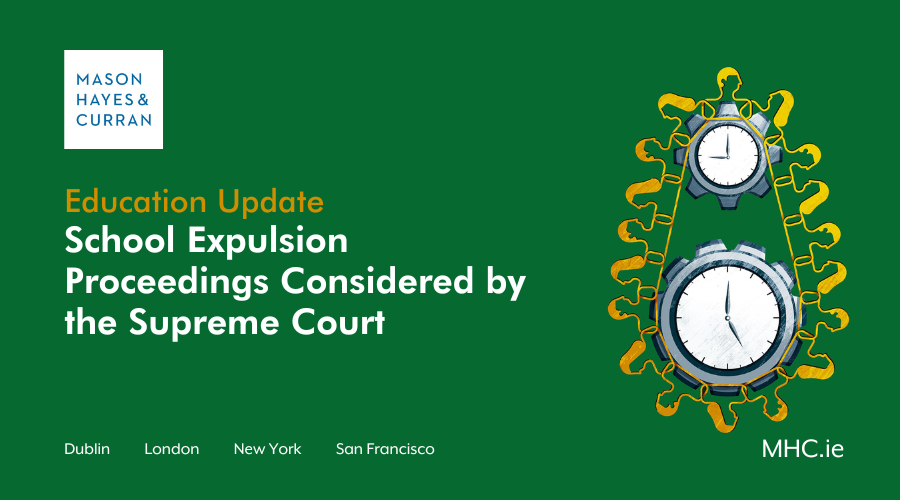School Expulsion Proceedings Considered by the Supreme Court

Our Education Law team successfully brought an appeal to the Supreme Court regarding a school expulsion. The Supreme Court has helpfully clarified some important principles that should be considered when dealing with school expulsions.
This case involved a secondary school student in his Junior Certificate year. Serious allegations of misconduct were made against him, including allegations of bullying directed at a fellow student in the school. In the wake of these allegations, the Board of Management met and made a preliminary decision to expel the student from the school.
The student’s solicitors wrote to the Principal. They called upon him to permit the student to remain in the school pending the outcome of a statutory Section 29 appeal of the expulsion decision to the Department of Education.
The school replied saying that there was no provision in the Department of Education’s procedures, “whereby a student could remain in a school pending a final determination of a Board of Management meeting that the student in question should be permanently excluded.”
High Court proceedings
Following a further exchange of correspondence, the student commenced judicial review proceedings in the High Court. Mr Justice Meenan granted an order staying the decision of the Board of Management to expel the student from the school pending the determination of the Section 29 appeal. The school argued that Section 29 does not itself provide for any stay procedure pending the outcome of the appeal.
The school applied to the High Court to have the interim injunctive orders which had been granted by Mr Justice Meenan set aside. This application was refused. The school appealed this refusal to the Supreme Court.
Supreme Court decision
The Supreme Court held that the High Court fell into error in granting an order for the student to remain in the school pending the Section 29 appeal. The Supreme Court held that this action amounted to a grant of a mandatory interlocutory injunction on an ex parte basis. The Supreme Court held that this was problematic as the High Court had no authority to do so. Not only was the school not heard, but it also wrongfully put the onus of proof on the school to demonstrate why the injunction should be discharged.
The Supreme Court emphasised that an applicant for judicial review, in this case the student, is not entitled to a stay or injunction as a matter of right. In addition, the Supreme Court noted that these orders should not be made reflexively or as a matter of routine. Here, the order made by the Court was clearly mandatory in character. On that basis, the order could only have been granted if the applicant established a “strong case”. The application of this threshold was reinforced by the fact that there was never going to be a trial of the proceedings. That threshold was not met on the facts.
Most importantly for schools, the Supreme Court held that the High Court failed to give appropriate weight to the interests of the school and its students in the implementation of the school’s decision to expel the student. This was unchallenged in the proceedings. The Supreme Court held that it was a very significant imposition on the school, its management and staff to require it to allow the student to continue to attend in any capacity after the school made an assessment that his conduct warranted expulsion.
The Supreme Court held that the student’s behaviour created a clear risk to the welfare of teachers and of students enrolled in the school. It also noted that sufficient weight was not given to these matters by the judge. It stated that the High Court was wrong to constrain its assessment in that way. The weight of the material before the court indicated significant problematic behaviour by the student. The High Court wrongly discounted the concerns of the school and effectively substituted its judgment for that of the school’s. The Supreme Court stated that the Section 29 appeal was a speedy process and the student’s rights did not outweigh the rights and interests of the school, teachers and other students.
Comment
The key takeaway for schools is that it is now accepted that students who have been expelled should use the appeal provided for them under Section 29 of the Education Act 1998.
The Supreme Court has indicated that the courts should be very slow to make an order compelling a school to allow an expelled student to continue to attend school and should do so only in the clearest of cases. Finally, the Supreme Court has stated that one student’s rights do not outweigh the rights of other students, teachers, and the school.
We regularly advise on expulsion proceedings and have significant experience in ensuring that schools comply with fair procedures and the process is followed correctly. This case highlights that even when a school follows the procedures, it could be subject to legal proceedings. It is hoped that this decision provides further clarity to the highly litigated area.
For more information on school expulsions, contact a member of our Education Law team.
The content of this article is provided for information purposes only and does not constitute legal or other advice.
Share this:




